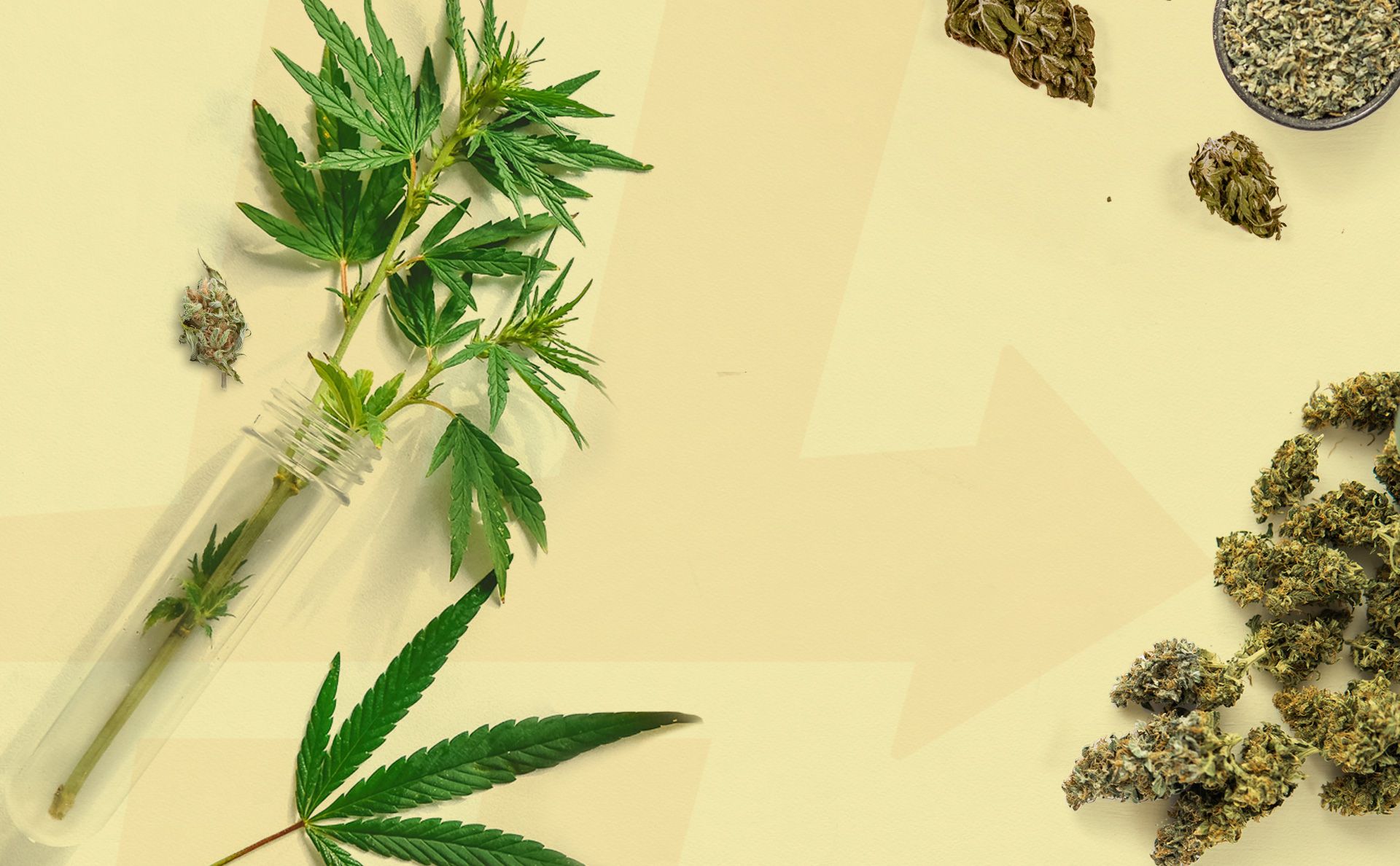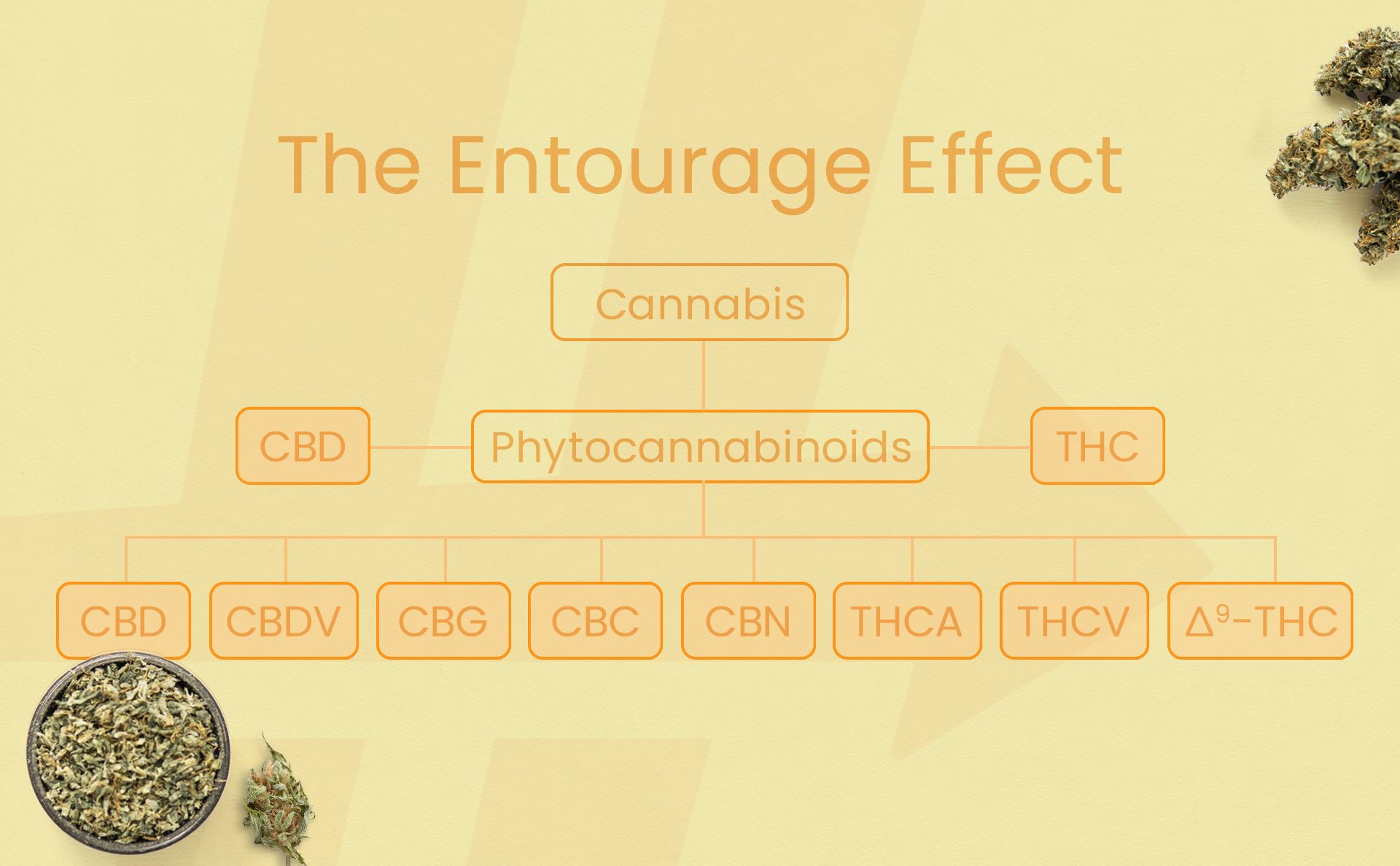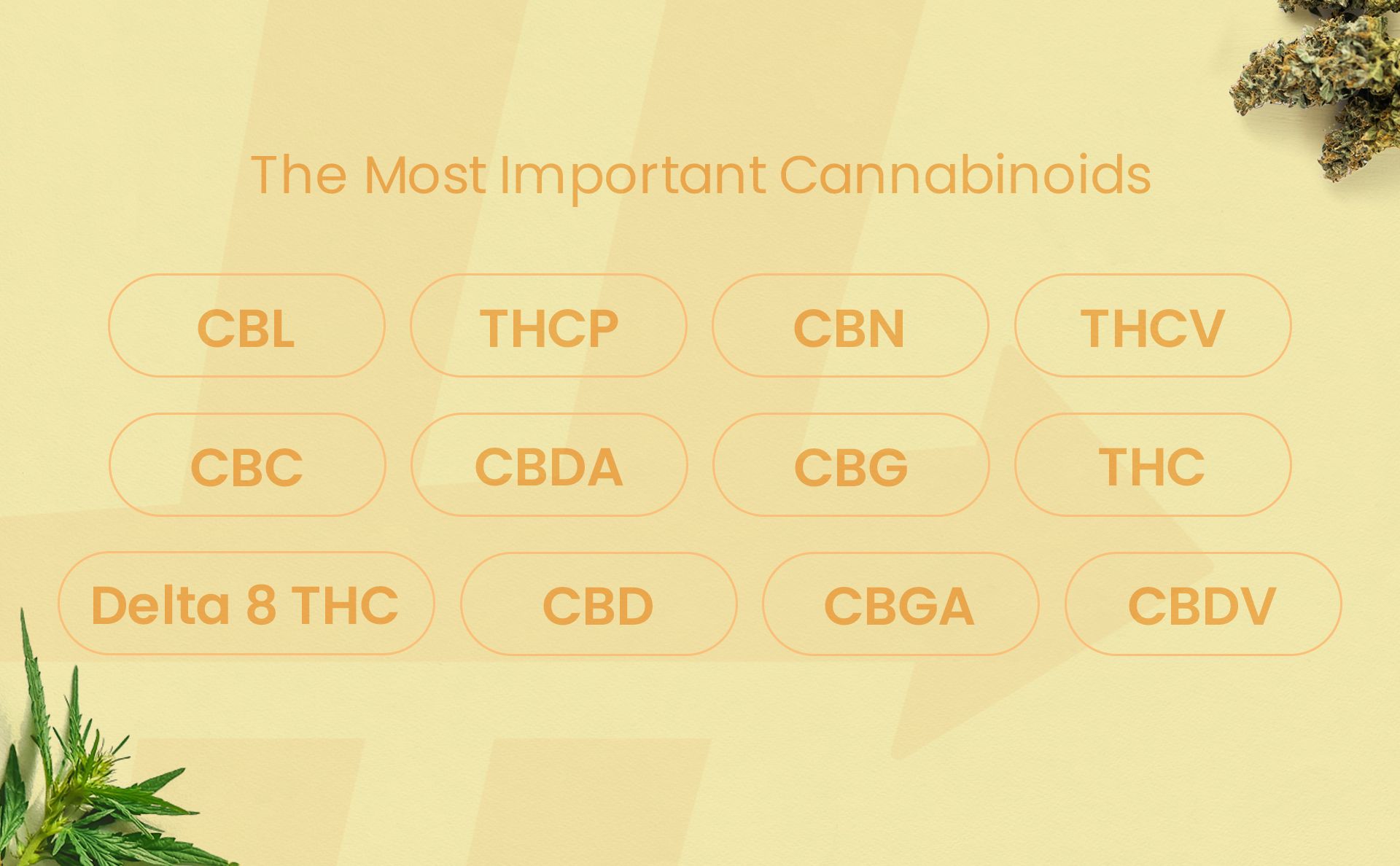Intro To Cannabinoids
Cannabinoids are the most important compounds found in cannabis, and are the most understood. This introductory chapter tells you everything you can expect to learn in our HashDash Cannabinoids Guide.

What are Cannabinoids?
Put simply, cannabinoids are organic and bioactive compounds that are found in the cannabis plant. Whole plant cannabis contains over 550 naturally occurring components. We currently know of almost 150 cannabinoids in the cannabis plant. The two cannabinoids we know the most about are tetrahydrocannabinol (THC) and cannabidiol (CBD). Beyond those, cannabis plants contain many other cannabinoids that show promising lab-based (preclinical) evidence, but lack sufficient clinical data at this time.
Plant-based cannabinoids are also called phytocannabinoids. Labs can also make fully-synthetic or semisynthetic forms of cannabinoids for medical (e.g., nabilone, dronabinol) and recreational use (i.e., delta 8). Semisynthetic cannabinoids in retail markets are usually made from converting hemp-derived CBD. However, natural cannabinoids are generally safer and favorable for their tolerability, accessibility, and practicality.
Our bodies, as well as almost every animal, make their own cannabinoids called endocannabinoids. Endocannabinoids actually don't resemble plant-based cannabinoids, but they do act on similar targets. We will describe the endocannabinoid system (ECS) in detail below.
In general, when people talk about cannabinoids, they really mean plant-based cannabinoids.
What is the Entourage Effect?
In addition to cannabinoids, the natural presence of whole-plant terpenes, flavonoids, alkaloids, and other compounds in combination can create a synergy called the “entourage effect”. Because of this, there are many proponents of whole-plant cannabis in its various forms, especially when it comes to extracts, oils, and concentrates.
Whole-plant formulations are favored by knowledgeable professionals and experienced consumers not only for their enhanced flavors and aromas – but also for enhanced therapeutic and recreational effects.

Many scientists and patients believe that the benefits of the entire cannabis plant are more influential than isolating a single cannabinoid like CBD. There is a limited scientific research basis to back up this line of thinking – particularly for:
- Pain
- Inflammation
- Anxiety and depression
- Addiction
- Seizures and epilepsy
- Cancer
- Fungal and bacterial infections
While direct clinical evidence on the entourage effect is lacking, there is a plethora of anecdotal evidence and real-world healthcare experiences using whole-plant cannabis medicine with patients.

What the expert says...
Dr. Abraham Benavides
"Whole plant cannabis contains over 550 naturally occurring components. We currently know of almost 150 cannabinoids in the cannabis plant."
Decarboxylation
Most people think of THC and CBD when it comes to cannabinoids because these are the two compounds that are most abundant, and the ones we currently understand the most about. Interestingly, THC and CBD aren’t produced directly within cannabis flower – their parents are.
Instead, these cannabinoids are created through a process known as decarboxylation, or “decarbing” for short. Decarboxylation turns acidic, parent cannabinoids into their corresponding and better-known neutral forms. Most cannabis cultivars contain the acidic cannabinoids like THCA, CBDA, or CBGA in the highest concentrations. Decarboxylation is the reason you can’t get high from simply eating, juicing, or smelling raw cannabis plants.
The most common way of decarboxylating THCA and CBDA is with heat: vaping, cooking raw cannabis to make edibles, or smoking. As the industry grows, and we continue to learn more about cannabis plant medicine, we are discovering other ways of ingesting cannabinoids without decarboxylation. This goes hand-in-hand with learning more about cannabinoids and their potential benefits.
We used to think that decarboxylation is necessary to “activate” acidic cannabinoids. In a sense, this is only true for conferring THC with intoxication. Now, we know it’s not the only way to get health benefits out of raw cannabis.
Equating decarboxylation with activation doesn’t convey the fact that the acidic parents themselves like THCA, CBDA, and CBGA are already biologically active compounds that may yield similar or greater therapeutic benefits in certain respects and non-intoxicating advantages.
Today, cold-pressing cannabis can yield extracts high in acidic cannabinoids and terpenes that many consumers use.
Major Cannabinoids Briefly Explained: “The Big Four”
While THC and CBD are the best-known, there are two other major cannabinoids that make up “the big four” most common cannabinoids. These are:
Clinical evidence on THC and CBD are much greater than CBC and CBG. Of these, only THC is intoxicating. You can read more about CBC and CBG in their respective guides.
THC is the main intoxicating cannabinoid found in cannabis, and CBD is non-intoxicating. This means that CBD-dominant products will not produce a “high”, unless there’s enough THC to go along with it. CBD is attractive for many cannabis consumers because it can deliver benefits without the impairment that comes with ingesting THC.
CBD products that are derived from hemp must contain less than 0.3% THC by dry weight to be sold legally in most states. Much debate is currently going on whether semisynthetic cannabinoids made from hemp-derived CBD are safe or effective. For much more in-depth information on the best-known cannabinoids, be sure to explore the rest of our guide.
Chemotypes vs. Chemovars vs. Cultivars
Chemotypes
Cannabis plants tend to favor production of a dominant cannabinoid profile over the other. This leads researchers to categorize cannabis plants into 5 broad chemotypes based on cannabinoid dominance. It’s also why 1:1 THC:CBD flower is a rare find.
According to researchers, the five cannabis chemotypes are:
Type I: THCA-dominant Type II: Roughly equal or 1:1 THCA and CBDA-dominant Type III: CBDA-dominant Type IV: CBGA-dominant Type V: Industrial, fibrous hemp devoid of cannabinoids
As we alluded to before, a type I, or THCA-dominant, flower will yield an intoxicating, THC experience once decarboxylated by heat or UV light.
Chemovars
While knowing and understanding a plant’s cannabinoid profile, or chemotype, is usually the first step and important – it is not the end-all-be-all of a particular cultivar or “strain”. When we combine the concepts of chemotypes with 200 known cannabis terpenes, we unlock the true diversity of cannabis in what we call chemovars.
Chemotypes are based solely on cannabinoids, which gives limited information. But a chemovar, short for chemical variety, is a distinct cannabinoid and terpene profile of grown plants. This is a more advanced and accurate categorization, rendering terms like “indica” and “sativa” scientifically obsolete. Most commercial strains are already heavily hybridized, so new categorizations like these are necessary.
Cultivars
A “cultivar” or cultivated variety refers to the complete profile of a selectively-grown plant that contains a one-of-kind amount of all its cannabis compounds – cannabinoids, terpenes, alkaloids, flavonoids, and sulfuric and phenolic compounds.
Cultivars are a better term for what are colloquially known as “strains”, and have over 700 colorfully recorded names that are familiar to most consumers. Unfortunately, these names don’t accurately represent every cultivar, which can vary between growers, regions, and even within generations. A cultivar has a unique biological profile that is specific to the plant you’re actually holding and may not be 100% reproducible without advanced genetic techniques.
Most Important Cannabinoids
Science has discovered about 150 cannabinoids at this time, but there are only about a dozen that show at least a preclinical degree of promise. These are the most important cannabinoids:
- THC
- CBD
- Delta-8 THC
- CBGA
- CBG
- CBC
- CBDA
- CBN
- CBL
- THCP
- THCV
- CBDV

What is the Endocannabinoid System?
Cannabinoids interact with the endocannabinoid system (ECS), a complex system that signals cells in the human body and is existent in almost all animals – from primitive to complex. This system was discovered about 30 years ago, by scientific researchers who were studying THC. Even though there has been some research conducted on it, we don’t fully understand the ECS to its full potential quite yet.
Cannabinoid receptors are cell membrane receptors found throughout the human body and are a part of the endocannabinoid system. The endocannabinoid system is responsible for regulating our appetite, mood, metabolism, pain, and even memory. It is for this reason that many cannabis advocates, activists, and consumers believe that the cannabis plant is directly linked to human evolution in some capacity. This is yet another speculation that isn’t rooted in much data, and the research on it is still in its early stages.
Even for those of us who don’t consume cannabis, the ECS is ever-present and vital to our well-being. The ECS is found in nearly all species, with and without vertebrae. This has led to much musing and speculation whether the cannabis plant is intrinsically linked to humans.
What Science Tells Us About the ECS
The ECS plays a vital role in a wide array of bodily functions and processes. These include regulating appetite, and circadian rhythms that help you keep your sleep schedule, memory, reproductive system, and fertility, as well as mood.
Cannabis makes you hungry, can help you sleep, can help relieve pain, and puts you in a good mood. For these reasons, cannabis has been recommended for patients with cancer and chronic pain for millennia to help them find relief.
We still have much to learn about the ECS, but preliminary science does suggest that an imbalanced or disrupted ECS can lead to ailments like depression, sleeplessness, weight gain or loss, and so on. This idea is called clinical endocannabinoid deficiency, and may underlie diseases not yet explained by Western medicine such as fibromyalgia, irritable bowel syndrome, migraines, neurological conditions, and more.
Plant-based cannabinoids can trigger the same endocannabinoid (CB) receptors to produce therapeutic effects. Beyond that, they have dozens of non-CB targets in the rest of the body that may provide further therapeutic effects. This concept of an expanded target set beyond the ECS is also called the endocannabinoidome (eCBome), and may also help regulate the gut-brain-axis and lipidome.
Balance Found in Nature
Natural balance is usually referred to as homeostasis, and all living things seek to maintain that balance. Staying close to our comfort zone is linked to the ECS: giving us the desire to keep cool in the summer, warm in the winter, eat when we are hungry, sleep when we’re tired, and so on.
We know there are three basic parts of the ECS:
- Endocannabinoids (e.g., anandamide and 2-AG)
- Cannabinoid receptors (e.g., CB1 and CB2)
- Enzymes that make and break down cannabinoids (e.g., FAAH, MAGL)
Cannabinoid receptors are found on the surface of cells in the body. Endocannabinoids are microscopic molecules that stimulate these receptors, and enzymes make and break down endocannabinoids when the body uses them. There are two main types of cannabinoid receptors throughout the body: CB1 and CB2. In the brain, CB1 receptors are some of the most abundant receptors. CB1 is what makes us feel high, but pretty much only responds to THC-like compounds and not CBD, CBG, their acidic parents, nor most of the minor cannabinoids.
CB2 receptors are mainly found existing outside the nervous system, in other areas such as the immune system. Just like there are over 100 cannabinoids that we still need to study, there are other cannabinoid-sensitive receptors in the body that are part of the eCBome and need more understanding.
At this time, CB1 and CB2 are the best-studied receptors because they were discovered first. This is also true for THC and CBD. Our chapter Cannabinoid Receptors covers the ECS in more depth, so be sure to check that out.
What We Learned: Intro To Cannabinoids
Cannabinoids are as fascinating as they are complex. Here’s what we learned in our Intro to Cannabinoids chapter:
- Whole plant cannabis contains over 550 naturally occurring components. We currently know of almost 150 cannabinoids in the cannabis plant.
- The two main cannabinoids are THC and CBD.
- THC is the intoxicating cannabinoid found in Cannabis, and CBD is non-intoxicating.
- Cannabinoids interact with the endocannabinoid system (ECS), which is a complex system that signals cells in the human body and is existent in almost every animal.
- The ECS is tasked with regulating sleep, appetite, mood, and several other vital functions in the human body.
- There are two main types of cannabinoid receptors throughout the body: CB1 and CB2, and CB1 is what makes consumers feel high from THC.
There is still so much to learn about the wonderful world of cannabinoids, and we are just scratching the surface with our introduction chapter. We invite you to explore the rest of our Cannabinoids Guide and soak up the knowledge of these fascinating compounds that live naturally in all of our bodies. Answer the question below, and let's dive deeper into these incredible compounds.
Citations
- Chacon, F. T., Raup-Konsavage, W. M., Vrana, K. E., & Kellogg, J. J. (2022). Secondary Terpenes in Cannabis sativa L.: Synthesis and Synergy. Biomedicines, 10(12), 3142.https://doi.org/10.3390/biomedicines10123142
- Citti, C., Linciano, P., Russo, F., Luongo, L., Iannotta, M., Maione, S., Laganà, A., Capriotti, A. L., Forni, F., Vandelli, M. A., Gigli, G., & Cannazza, G. (2019). A novel phytocannabinoid isolated from Cannabis sativa L. with an in vivo cannabimimetic https://doi.org/10.1038/s41598-019-56785-1
- Geci, M., Scialdone, M., & Tishler, J. (2023). The Dark Side of Cannabidiol: The Unanticipated Social and Clinical Implications of Synthetic Δ8-THC. Cannabis and Cannabinoid Research, 8(2), 270–282.https://doi.org/10.1089/can.2022.0126
- Gloss, D. (2015). An Overview of Products and Bias in Research. Neurotherapeutics, 12(4), 731–734.https://doi.org/10.1007/s13311-015-0370-x
- Maioli, C., Mattoteia, D., Amin, H. I. M., Minassi, A., & Caprioglio, D. (2022). Cannabinol: History, Syntheses, and Biological Profile of the Greatest “Minor” Cannabinoid. Plants, 11(21), 2896.https://doi.org/10.3390/plants11212896
- Moreno-Sanz, G. (2016). Can You Pass the Acid Test? Critical Review and Novel Therapeutic Perspectives of Δ9-Tetrahydrocannabinolic Acid A. Cannabis and Cannabinoid Research, 1(1), 124–130.https://doi.org/10.1089/can.2016.0008
- Reimann-Philipp, U., Speck, M., Orser, C., Johnson, S., Hilyard, A., Turner, H., Stokes, A. J., & Small-Howard, A. L. (2020). Cannabis Chemovar Nomenclature Misrepresents Chemical and Genetic Diversity; Survey of Variations in Chemical Profiles and Genetihttps://doi.org/10.1089/can.2018.0063
- Rezende, B., Alencar, A. K. N., de Bem, G. F., Fontes-Dantas, F. L., & Montes, G. C. (2023). Endocannabinoid System: Chemical Characteristics and Biological Activity. Pharmaceuticals, 16(2), 148.https://doi.org/10.3390/ph16020148
- Rock, E. M., & Parker, L. A. (2021). Constituents of Cannabis Sativa. Advances in Experimental Medicine and Biology, 1264, 1–13.https://doi.org/10.1007/978-3-030-57369-0_1
- Russo, E. B. (2019). The Case for the Entourage Effect and Conventional Breeding of Clinical Cannabis: No “Strain,” No Gain. Frontiers in Plant Science, 9, 1969.https://doi.org/10.3389/fpls.2018.01969
- Silver, R. J. (2019). The Endocannabinoid System of Animals. Animals : An Open Access Journal from MDPI, 9(9), 686.https://doi.org/10.3390/ani9090686
- Siracusa, L., Ruberto, G., & Cristino, L. (2023). Recent Research on Cannabis sativa L.: Phytochemistry, New Matrices, Cultivation Techniques, and Recent Updates on Its Brain-Related Effects (2018–2023). Molecules, 28(8), 3387. https://doi.org/10.3390/molecules28083387
- Sommano, S. R., Chittasupho, C., Ruksiriwanich, W., & Jantrawut, P. (2020). The Cannabis Terpenes. Molecules, 25(24), 5792.https://doi.org/10.3390/molecules25245792
- Walsh, K. B., McKinney, A. E., & Holmes, A. E. (2021). Minor Cannabinoids: Biosynthesis, Molecular Pharmacology and Potential Therapeutic Uses. Frontiers in Pharmacology, 12, 777804.https://doi.org/10.3389/fphar.2021.777804
Test your knowledge, track your progress and earn your badge.
How many cannabinoids have been discovered?

Dr. Abraham Benavides
Dr. Abraham Benavides is an internationally-recognized cannabis research expert, experienced medical advisor, and full-tuition merit scholar of the George Washington University School of Medicine and Health Sciences. Dr. Abe enjoys helping patients as a writer, educator, and cannabis health coach at the GW Center for Integrative Medicine.